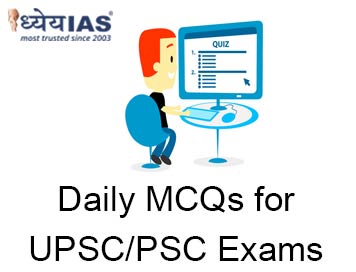Home > Daily-mcqs
Daily-mcqs 07 May 2025

Q1:
Match the following Articles of the Indian Constitution with their corresponding provisions related to the Supreme Court: Article Provision A. Article 124 1. Appointment of ad hoc judges from High Courts B. Article 126 2. Acting Chief Justice of India C. Article 127 3. Appointment and composition of Supreme Court judges D. Article 128 4. Reappointment of retired SC judges with consent of President Select the correct code:
A: A-3, B-2, C-1, D-4
B: A-2, B-1, C-4, D-3
C: A-1, B-3, C-2, D-4
D: A-4, B-2, C-3, D-1
Answer: A
Explanation:
Article 124 deals with the composition and appointment of Supreme Court judges. Article 126 provides for the Acting Chief Justice of India when the CJI is unable to perform duties. Article 127 allows the CJI to request ad hoc High Court judges to sit temporarily in the SC. Article 128 permits retired Supreme Court judges to rejoin the bench temporarily with the President's consent.
Q2:
With reference to INS Tamal, how many of the following statements are correct? Choose from the options below:
A: Only one
B: Only two
C: Only three
D: All four
Answer: C
Explanation:
Statements 1, 2, and 3 are correct. INS Tamal carries Kamov helicopters for anti-submarine warfare, is equipped with torpedoes and Shtil SAMs, and includes advanced stealth features. However, Statement 4 is incorrect—Project 17A is an entirely Indian frigate development program. INS Tamal belongs to an Indo-Russian project (Krivak-III upgrade), not Project 17A.
Q3:
Which of the following best exemplifies a piezocatalytic process as seen in the metal-free COF system for hydrogen production?
A: Use of sunlight to split water molecules.
B: Applying mechanical vibrations to generate hydrogen gas.
C: Heating the catalyst to high temperatures for energy release.
D: Reacting metals with acids to release hydrogen.
Answer: B
Explanation:
Piezocatalysis refers to catalysis triggered by mechanical force, not light or heat. In this case, ambient vibrations cause charge separation (electron-hole pairs) within the COF due to dipolar lattice instability, leading to water splitting and hydrogen generation. This method stands apart from traditional photochemical or thermal hydrogen production by being sustainable, low-cost, and reliant on environmental mechanical stimuli rather than electricity or sunlight.
Q4:
With reference to the constitutional provisions related to inter-state river water distribution, consider the following: How many of the above statements are correct?
A: Only one
B: Only Two
C: All three
D: None
Answer: B
Explanation:
Statement 1 is incorrect because Entry 17 gives states power over water supply and irrigation, but not exclusive power in the case of inter-state rivers due to the overriding Entry 56 in the Union List. Statement 2 is correct—Entry 56 empowers the Union government to legislate for the regulation and development of inter-State rivers. Statement 3 is also correct—Article 262 allows Parliament to enact laws like the Inter-State River Water Disputes Act for the adjudication of such disputes. Hence, two statements are correct.
Q5:
Consider the following statements regarding India’s Human Development status in 2023: How many of the above statements are correct?
A: All four
B: Only two
C: Only three
D: None
Answer: D
Explanation:
None of the Statements are correct. India ranks 130th, higher than Nepal (145th) and shares the same rank with Bangladesh. Its rank also improved from 133rd in 2022 to 130. India is still in the “medium human development” category, not high.